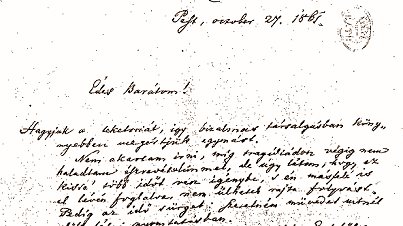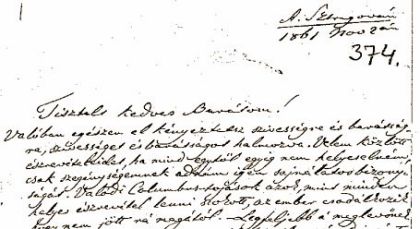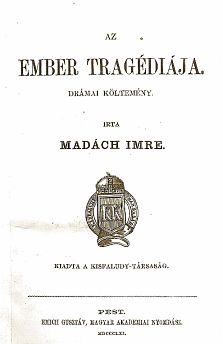How the drama was made
On the manuscript of the dramatic poem
|
"... I mentioned to several of my acquaintances that I had written a poem featuring God, the devil, Adam, Luther, Danton...; that it started with creation, was playing in heaven and on the entire globe and in space - they acknowledged this with a smile, but no one wanted to read it. - Then finally I read it to our friend, Pál Szontágh last spring and he encouraged me to submit it to Arany for his review", wrote Imre Madách in his letter to Iván Nagy on November 2nd, 1861.
He was aware of the fact that what he had authored "was different from our ordinary plays". According to Arany, Madách - because "his thoughts were more powerful than his imagination" - found satisfaction not so much in the drama of the characters and the events but rather he was interested in the conflict of thoughts and ideas. The real talent of a playwright was missing from him, although his poetic commitment was hungry for appreciation. And so Arany's judgement was important for him.
Madách worked by writing on scraps of paper, and he kept his notes grouped in categories until his work of art was finished, and when it was, he destroyed them together with any drafts and any other attempts. As a result, what remained of these scraps written for The Tragedy of Man was barely more than Madách's own handwritten list of the characters, showing the date on which he started writing and the date of ending his work, plus the size of the individual scenes. The first version consisted of 4080 lines, if the 23 lines borrowed from the book of Psalms are excluded.
|
On the backside of this note three fragments can be read from the 11th (London) scene. We also have some other slips of paper on which certain parts of the Tragedy can be found, sometimes in the form of mere idea-bits, and sometimes written almost word-for-word identical with the finished text.
Not more than a single manuscript of the Tragedy of Man existed; it is now kept in the archives of the National Academy of Sciences' Library. A facsimile edition of the manuscript was published in 1973. Madách wrote in 1861: "... I do not have a copy of the manuscript...". And when he revised the second edition of the Tragedy, he did not work from the manuscript that had been left in Pest, instead he relied on the text of the first edition.
|
The circumstances of the Tragedy's publication
As it is known, Arany unenthusiastically put aside the manuscript received from this unknown provincial landlord after he had ran his eyes through the first scene. Madách's fellow Member of Parliament, Pál Jámbor, who was a priest and a poet himself, intervened for him and Arany read the manuscript to the end for the second time. In his letter of 12th September, 1861 sent to Madách János Arany commented on the poem as follows: "The Tragedy of Man is a remarkable work of art both in concept and composition ... I spotted some clumsiness only here and there in the metrics and the diction." He then offered: "I would make some corrective strokes with my pen, myself..." Madách received Arany's comments and suggested corrections gratefully.
|
It was János Arany, who presented the work to the greater audience at the meeting of the Kisfaludy Society on October 31st, and he read out parts of the dramatic poem during the evening. Later he took upon himself the work of preparing it for the press. The facsimile of the manuscript published in 1973 makes it apparent to anyone that Arany had not made any changes to the concept or content of the Tragedy. The volume, sponsored by the Kisfaludy Society left Gusztáv Emich's printing house on January 16th, 1862, although it showed 1861 as the year of publication. The number of copies is not known. The "second, significantly corrected" edition published in 1863 included the corrections suggested by Károly Szász, too.
The Kisfaludy Society elected the author of the Tragedy of Man a member on January 16th, 1862, while the Hungarian Academy of Science made him a member on January 13th, 1863. Since then more than 110 Hungarian editions of this work have been published. It has been translated to and is available in thirty languages. Since its premiere on September 21st, 1883 it has been played more than 1400 times in the National Theatre only. Imre Madách has thus entered the prestigious company of national classic authors and world literature.
He was never able to surpass the artistic peak he had achieved in the Tragedy in his remaining lifetime, neither in Moses submitted to the Hungarian Academy of Sciences for their drama competition, nor in his revised play, The Last Days of Csák. Still in February 1864 he began preparing a collective edition of his poetic works, but by April he grew so weak that he was not able to read his own inaugural address at the Academy - his fellow-poet, Károly Bérczy had to read it for him. He died before he turned 42.
Thus, to quote Béla Németh G., Madách remained for us: "a single-book, single-genre author".



